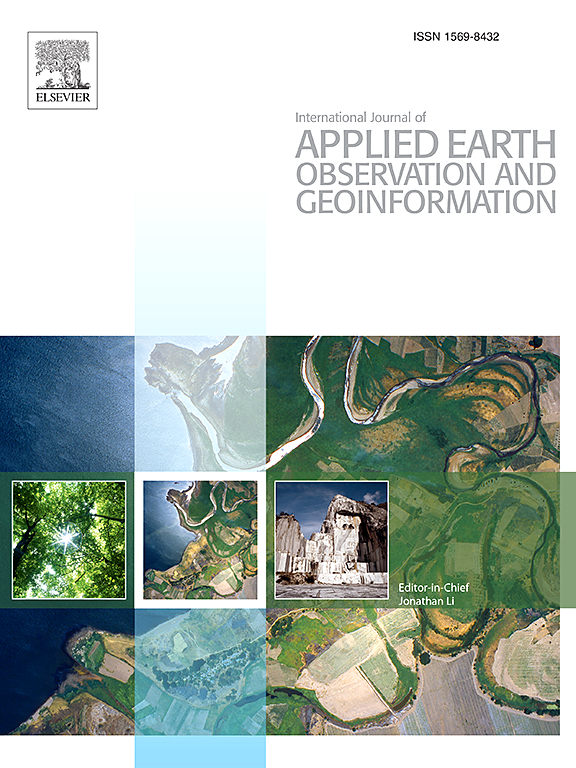An improved height sampling approach used for global urban building height mapping
IF 8.6
Q1 REMOTE SENSING
International journal of applied earth observation and geoinformation : ITC journal
Pub Date : 2025-05-30
DOI:10.1016/j.jag.2025.104633
引用次数: 0
Abstract
Building height serves as fundamental information for characterizing urban landscapes and morphology, as influencing various aspects of the urban environment. While traditional methods of obtaining building height are often limited by spatial coverage and proprietary constraints, remote sensing data provides an alternative for indirect estimation. Several height products developed across different spatial scales, yet challenges remain due to the spatial and temporal incompleteness of publicly available building height samples, which introduce inherent uncertainties in global height mapping. This study proposed an improved approach for building height sampling that combines the ALOS AW3D30 and Global Ecosystem Dynamics Investigation (GEDI) data. Both datasets are open-access, providing a more comprehensive and representative sample base for model construction. To address temporal discrepancies between these two data, continuous change detection and classification (CCDC) algorithm was employed to remove invalid height samples. Subsequently, we trained random forest (RF) models using a combination of multi-source remote sensing data, including radar data, optical data, nighttime light data, terrain data, and footprint data, to generate a global urban building height map for the year of 2020. Reference samples from Europe, the United States, and China were employed to validate the model, indicating a high degree of consistency between the references and estimated results (R2 = 0.55–0.75, RMSE = 4.71–10.07 m). Moreover, our findings indicated that over 20 % of regions globally experienced rapid urbanization, with average building heights exceeding 10 m, particularly in southern China. The approach proposed in this study provides effective support for building height estimation, particularly in address the limitations of lack of incomplete and representative height samples in global mapping.
一种用于全球城市建筑高度映射的改进高度采样方法
建筑高度是表征城市景观和形态的基本信息,影响着城市环境的各个方面。虽然获取建筑物高度的传统方法往往受到空间覆盖和专有限制的限制,但遥感数据提供了一种间接估计的替代方法。在不同的空间尺度上开发了几种高度产品,但由于公开的建筑高度样本在空间和时间上的不完整性,这在全球高度制图中引入了固有的不确定性,因此仍然存在挑战。本研究提出了一种结合ALOS AW3D30和全球生态系统动力学调查(GEDI)数据的建筑高度采样改进方法。这两个数据集都是开放获取的,为模型构建提供了更全面、更有代表性的样本库。为了解决这两个数据之间的时间差异,采用连续变化检测和分类(CCDC)算法去除无效高度样本。随后,我们使用多源遥感数据(包括雷达数据、光学数据、夜间灯光数据、地形数据和足迹数据)组合训练随机森林(RF)模型,生成2020年全球城市建筑高度图。采用来自欧洲、美国和中国的参考样本对模型进行验证,结果表明参考文献与估计结果高度一致(R2 = 0.55-0.75, RMSE = 4.71-10.07 m)。此外,我们的研究结果表明,全球超过20%的地区经历了快速城市化,平均建筑高度超过10米,特别是在中国南方。本文提出的方法为建筑物高度估计提供了有效的支持,特别是解决了全球测绘中缺乏不完整和代表性高度样本的局限性。
本文章由计算机程序翻译,如有差异,请以英文原文为准。
求助全文
约1分钟内获得全文
求助全文
来源期刊

International journal of applied earth observation and geoinformation : ITC journal
Global and Planetary Change, Management, Monitoring, Policy and Law, Earth-Surface Processes, Computers in Earth Sciences
CiteScore
12.00
自引率
0.00%
发文量
0
审稿时长
77 days
期刊介绍:
The International Journal of Applied Earth Observation and Geoinformation publishes original papers that utilize earth observation data for natural resource and environmental inventory and management. These data primarily originate from remote sensing platforms, including satellites and aircraft, supplemented by surface and subsurface measurements. Addressing natural resources such as forests, agricultural land, soils, and water, as well as environmental concerns like biodiversity, land degradation, and hazards, the journal explores conceptual and data-driven approaches. It covers geoinformation themes like capturing, databasing, visualization, interpretation, data quality, and spatial uncertainty.
 求助内容:
求助内容: 应助结果提醒方式:
应助结果提醒方式:


